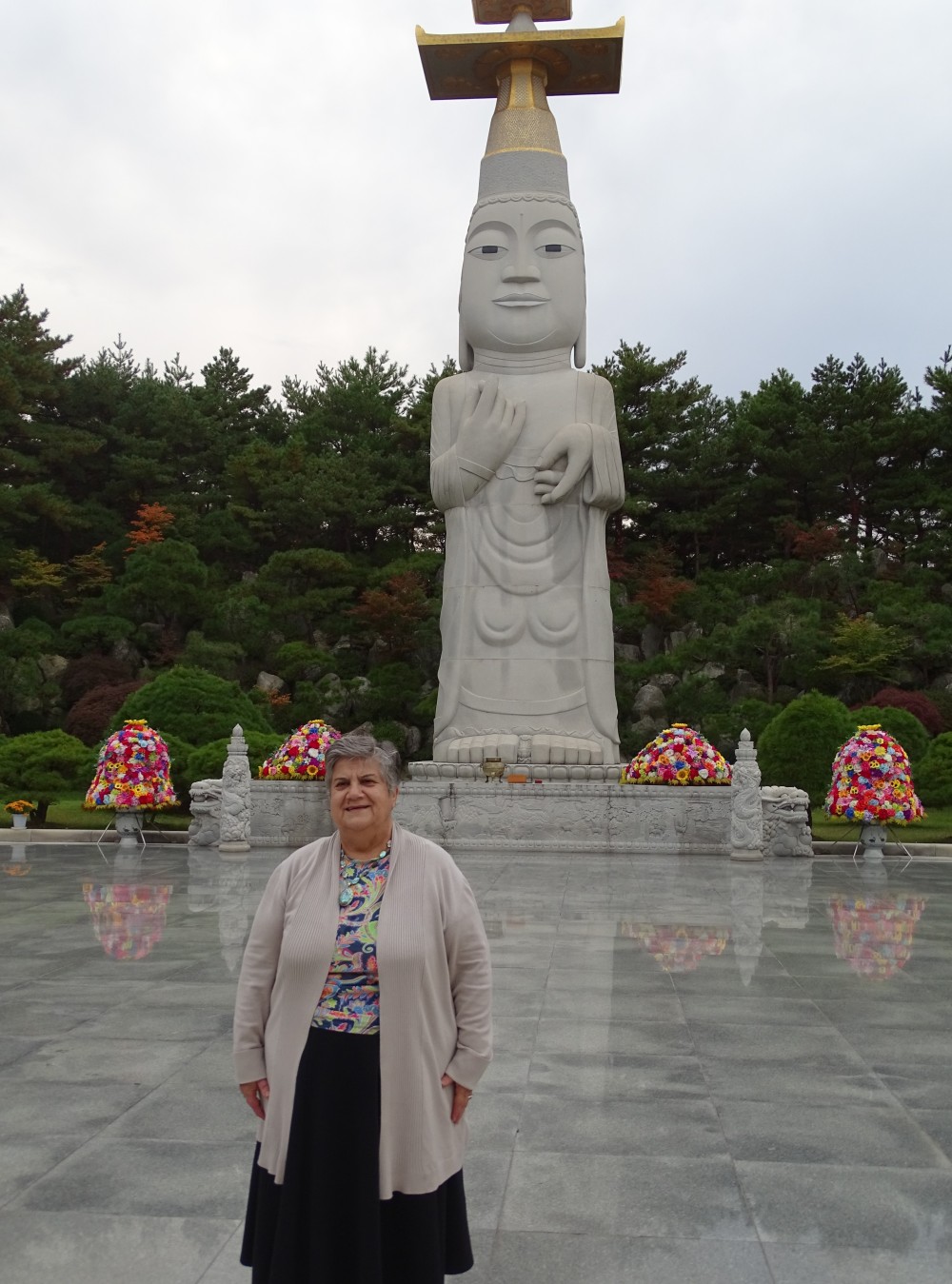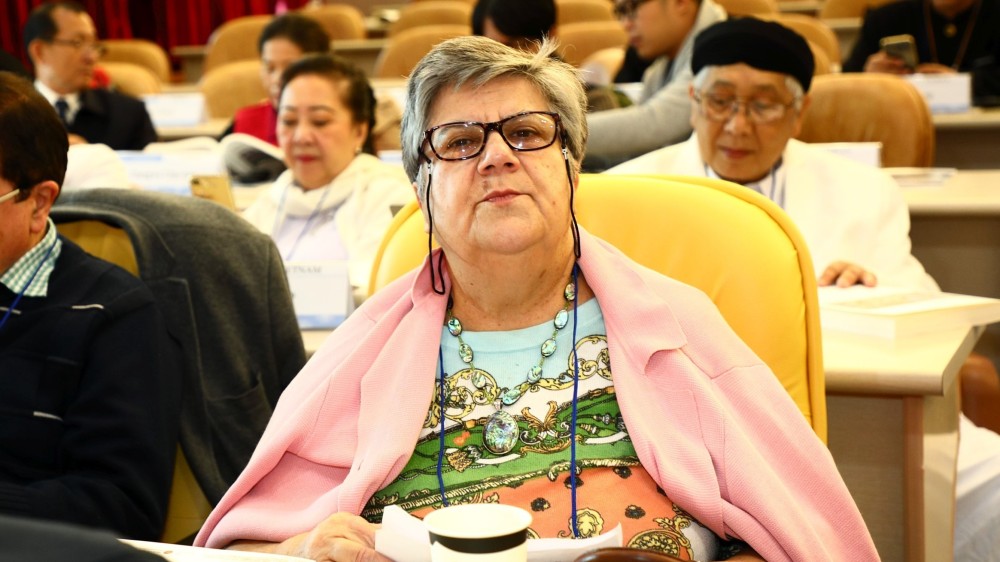- Reflections on Daesoon Jinrihoe as a Gateway to Korea (Bernadette Rigal-Cellard)
- 2021-04-21
 Daesoon Jinrihoe has been my miraculous key to the wonders of South Korea. In the pages that follow, I briefly will recall my fascinating discovery of Daesoon Jinrihoe. The starting point actually begins with my prior exposure to Korea. As a professor of American Studies, I have taught on US expansionism into the Pacific and thereby the Korean War. The next noteworthy instance of previous exposure came when Professor Bona Kim Lee (Korean Department), a scholar of Korean Buddhist poetry, asked me to publish Korean textbooks for French speakers. Despite some administrative resistance, I immediately accepted, and the books proved to be a great success. I almost met with Daesoon Jinrihoe in 2016 when CESNUR (Center for the Study of New Religions) held their conference at Daejin University, but sadly I could not attend it as I was undergoing surgery.
Daesoon Jinrihoe has been my miraculous key to the wonders of South Korea. In the pages that follow, I briefly will recall my fascinating discovery of Daesoon Jinrihoe. The starting point actually begins with my prior exposure to Korea. As a professor of American Studies, I have taught on US expansionism into the Pacific and thereby the Korean War. The next noteworthy instance of previous exposure came when Professor Bona Kim Lee (Korean Department), a scholar of Korean Buddhist poetry, asked me to publish Korean textbooks for French speakers. Despite some administrative resistance, I immediately accepted, and the books proved to be a great success. I almost met with Daesoon Jinrihoe in 2016 when CESNUR (Center for the Study of New Religions) held their conference at Daejin University, but sadly I could not attend it as I was undergoing surgery.In 2017, I finally had a chance to encounter Daesoon Jinrihoe while Visiting Weixin Shengjiao. The following year, Massimo Introvigne, Rosita Soryte, Gordon Melton, and I were invited by Grand Master Hunyuan Chanshi of Weixin Shengjiao and his daughter Fiona Chang to attend the Chinese United Ancestors Worship Ceremony on January 1st, 2017 in Taipei. A Daesoon Jinrihoe delegation was also in attendance, and this was when I started to learn about Daesoon Jinrihoe and their connection to Weixin Shengjiao.
The following spring, representatives of Daesoon Jinrihoe, Weixin Shengjiao, and Cao Dai traveled to Europe to attend an international conference on Daoism. I invited all of them to present on their religions at my university, University of Bordeaux Montaigne. Lee Gyungwon, a professor from the Department of Daesoon Theology, and Taesoo, a research member from the Daesoon Academy of Sciences (DAOS), presented on Daesoon Jinrihoe. Chairman Bae Kyuhan chaired the delegation.
My next encounter with Daesoon Jinrihoe came when DAOS invited us to participate in the first World Sangsaeng Forum titled, “Peace and the Path of Mutual Beneficence,” which was held at Daejin. For that forum, I offered a presentation titled, The Strategies Devised by Religions in Order to Promote Peace in the World: Christian and East Asian Dialogues and Interactions. The highlight of our stay was visiting Daesoon Jinrihoe’s Yeoju Headquarters Temple Complex. I recall being overwhelmed by its architectural and spiritual perfection. The dancheong woodwork, the uniqueness of the buildings, and the intense sacredness of Yeongdae impressed me profoundly. Cha Ikje gave a detailed theological explanation of the wall mural series, the Ox-seeking Pictures. I definitely rank Yeoju Headquarters Temple Complex among the most aesthetically satisfying sites I have ever visited. After returning home, I organized a joint lecture with my friend Stéphane Couralet, Chair of the Korean Studies Department, to share what I had learned. He supplemented my photos with his knowledge of Korean history and culture. In March of that year, I presented on Weixin Shengjiao and Daesoon Jinrihoe as two examples of the revitalization of religion in East Asia for Association Thot in Bordeaux. The following year, I was invited to participate in a conference organized by the University of Riga (Latvia) on “Dynamic Asia: Shaping the Future.” I spoke on Daesoon Jinrihoe: Reclaiming the Past to Improve the Future.
Weixin Shengjiao hosted the 2018 CESNUR Conference from June 18-21 at their university in Nantou, Taiwan. Weixin Shengjiao, Daesoon Jinrihoe, and Cao Dai signed a memorandum of understanding (MOU) to formally commit to the continual sharing of projects and friendship. Massimo asked me to give the plenary lecture in honor of the late Jane Williams-Hogan, our long-time friend. I spoke about the three MOU member-groups. I appraised their activities through the Revitalization Theory of Anthony F. C. Wallace.
In 2018, DAOS invited us back to participate in the second World Sangsaeng Forum at Daejin from October 20-24. I spoke on The Navigatio of Saint Brendan, a narration of an Irish monk’s quest for an Earthly Paradise among the islands of the Atlantic Ocean. I entitled it, The Quest for the Earthly Paradise in Christian and Post-Christian Europe. Following the conference, we revisited Yeoju and also went to Geumgangsan Toseong Training Temple Complex. I paid my respects to Park Wudang, and it was so satisfying to finally see Daesoon Jinrihoe’s signature icon of Maitreya Buddha. The explanations by the chairman of the temple were likewise precious.
 At this point in my reflection, it might be of interest to mention the human factor in researching and interacting with Daesoon Jinrihoe. Each time we visited Daesoon Jinrihoe, from the moment we landed, our hosts took care of us, translated, offered explanations, and took our queries. We were treated like royalty every minute of the day and not just because of all of the fine dining and memorable banquets. I have started to study Korean at the university here in order to better interact next time I go to Korea.
At this point in my reflection, it might be of interest to mention the human factor in researching and interacting with Daesoon Jinrihoe. Each time we visited Daesoon Jinrihoe, from the moment we landed, our hosts took care of us, translated, offered explanations, and took our queries. We were treated like royalty every minute of the day and not just because of all of the fine dining and memorable banquets. I have started to study Korean at the university here in order to better interact next time I go to Korea.In 2020, precautions regarding COVID-19 resulted in the Third World Sangsaeng Forum being held online. Meanwhile, a full lockdown in France meant more time than usual to write. Increasingly familiar with Daesoon Theology, I explored a poignant image from Daesoon Jinrihoe’s promotional video: the cosmic ball of fire that hits Korea to represent the incarnation of Sangje as Kang Jeungsan. Inspired by this, I composed a nuanced comparison titled, Incarnation and Divine Essence in Daesoon Thought: Their Specificity as Compared to the Christian Ones. I worked a full month exclusively on the topic as it was profoundly fascinating to me.
More recently, in December of 2020, the Korean Studies Center of Riga University organized another online conference. Using my recently received copy of The Scriptures of Daesoon Jinrihoe and The Dao Constitution of the Dao, I developed some ideas from 2018 into a paper, Daesoon Jinrihoe Analyzed in Light of Anthony F. C. Wallace’s Revitalization Theory. Whenever writing about Daesoon Jinrihoe, I have two goals in mind: 1.) make Daesoon Jinrihoe more understandable to English-speakers 2.) Provide a European perspective on Daesoon Jinrihoe. The next time I conduct field research in Korea, I hope to revisit Daejin University to ask a million questions to Daesoon scholars to perfect my knowledge of the religion because texts alone are not enough. The crown of it all would be to spend more time in Yeoju Headquarters Temple Complex which, in my eyes, is a little piece of paradise already fully realized on earth in beauty and friendship.
Bernadette Rigal-Cellard
Professor Emeritus in American and Religious Studies- Université Bordeaux Montaigne, France
